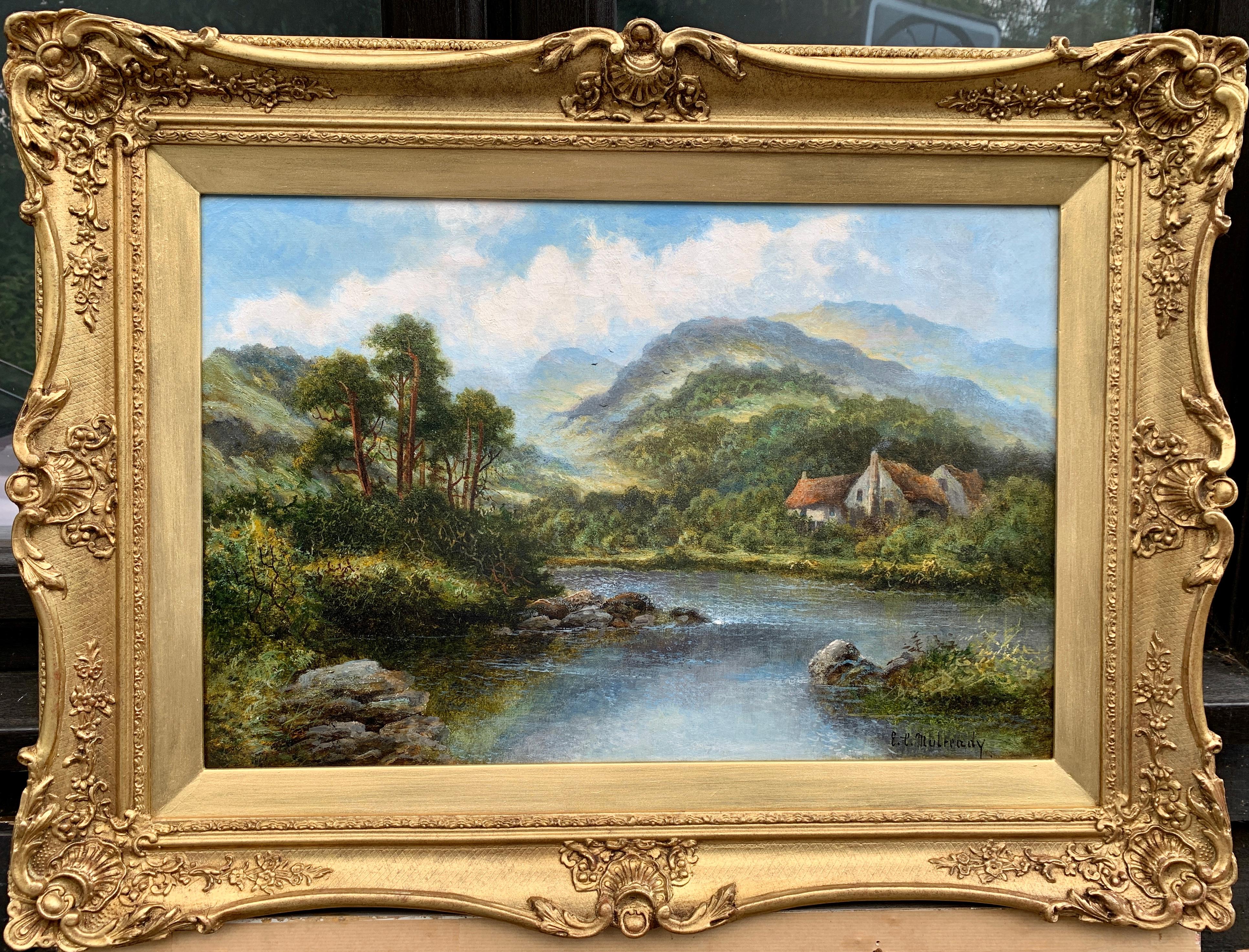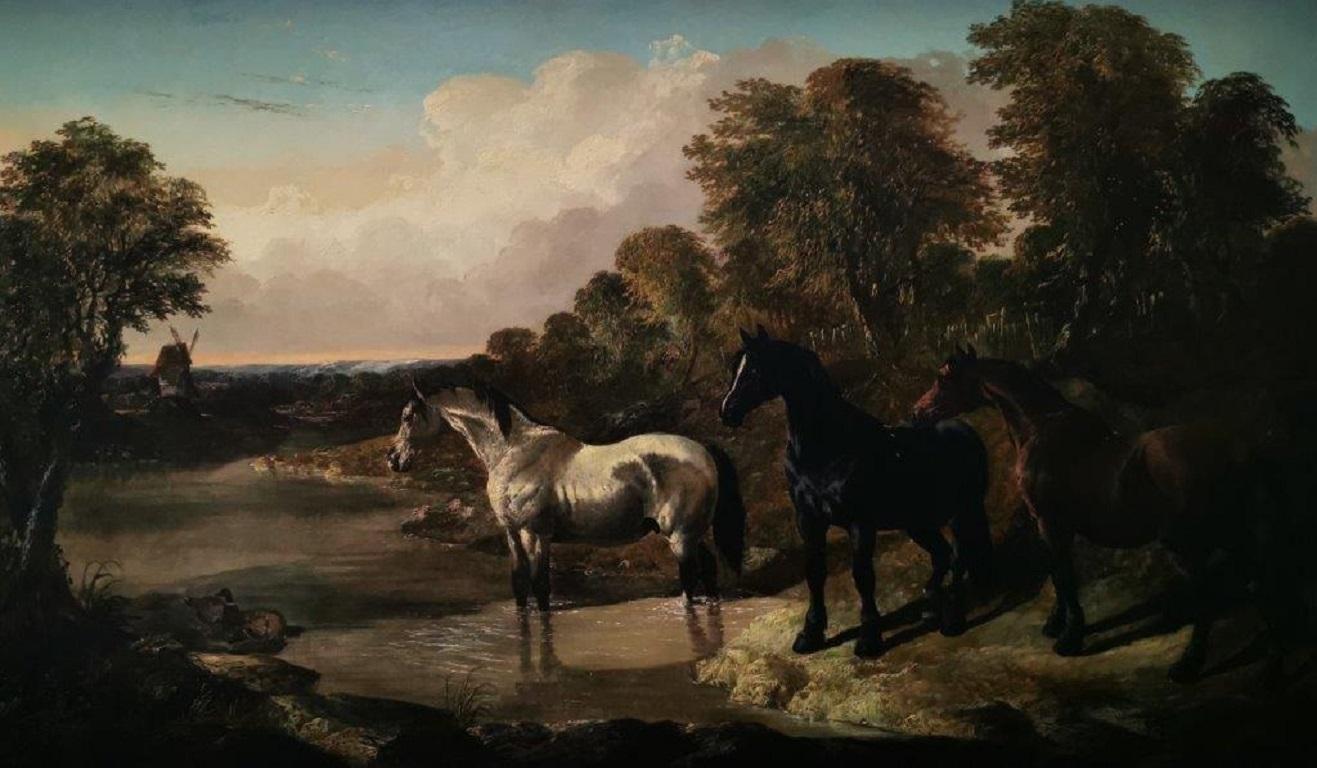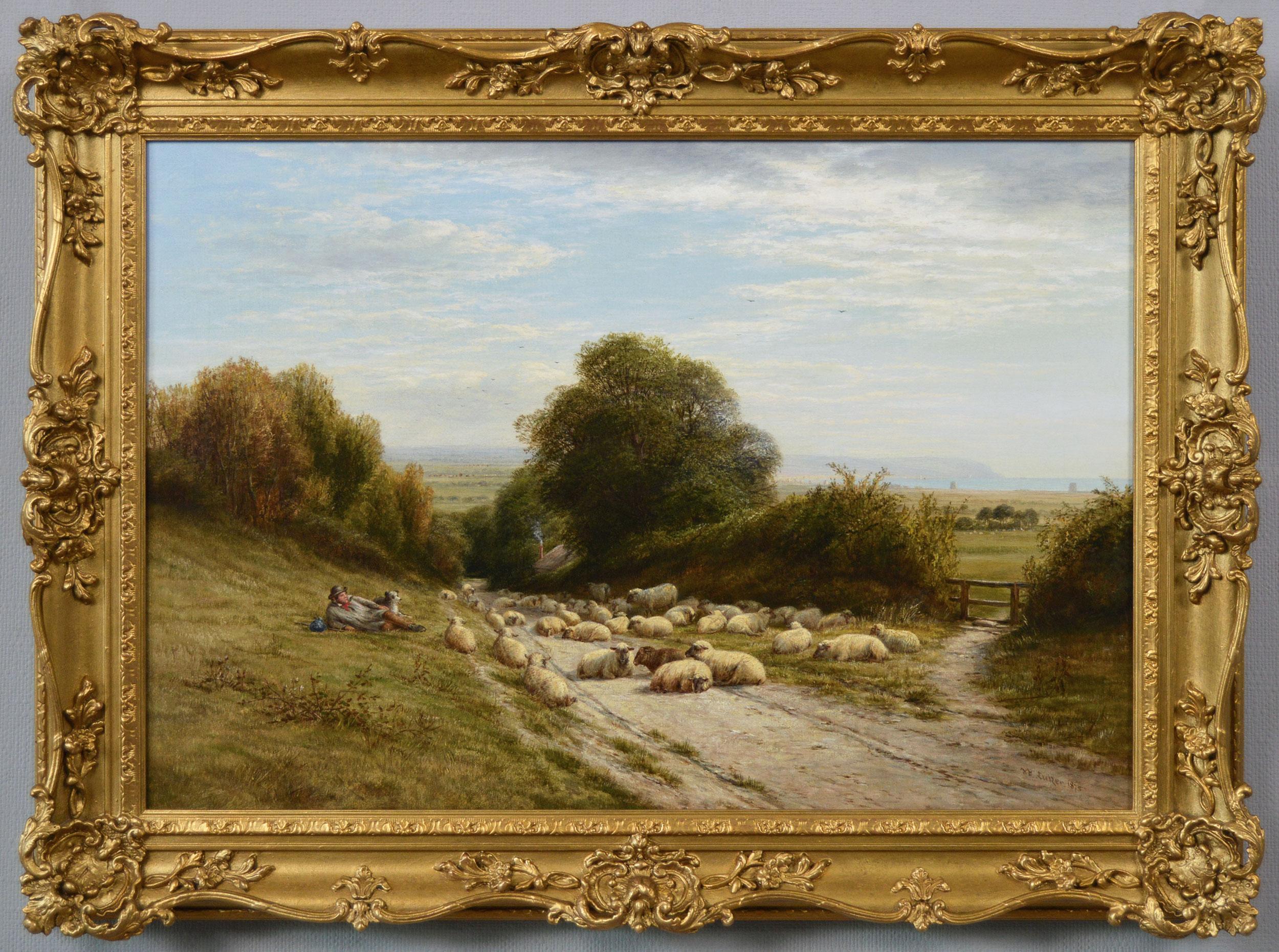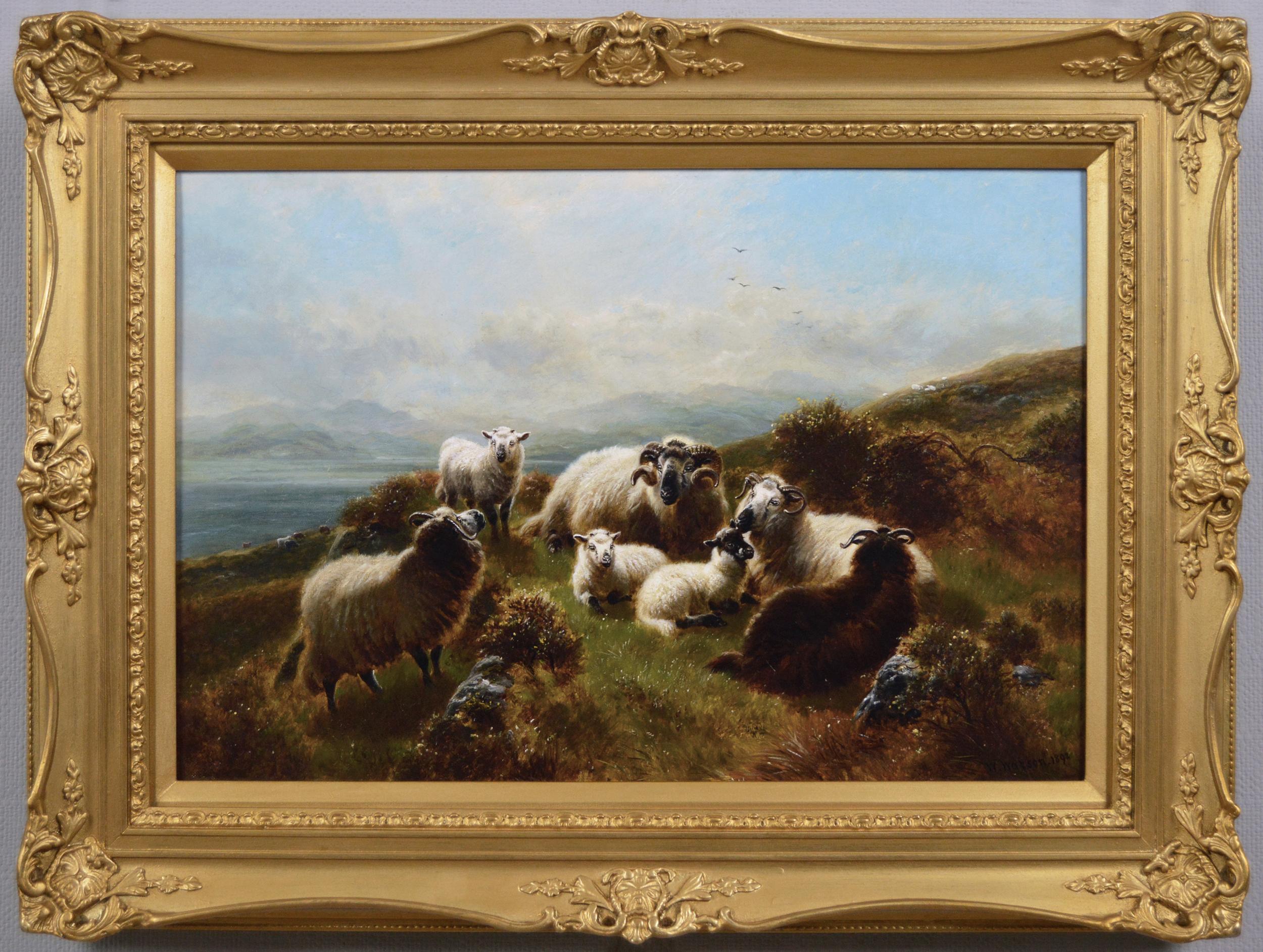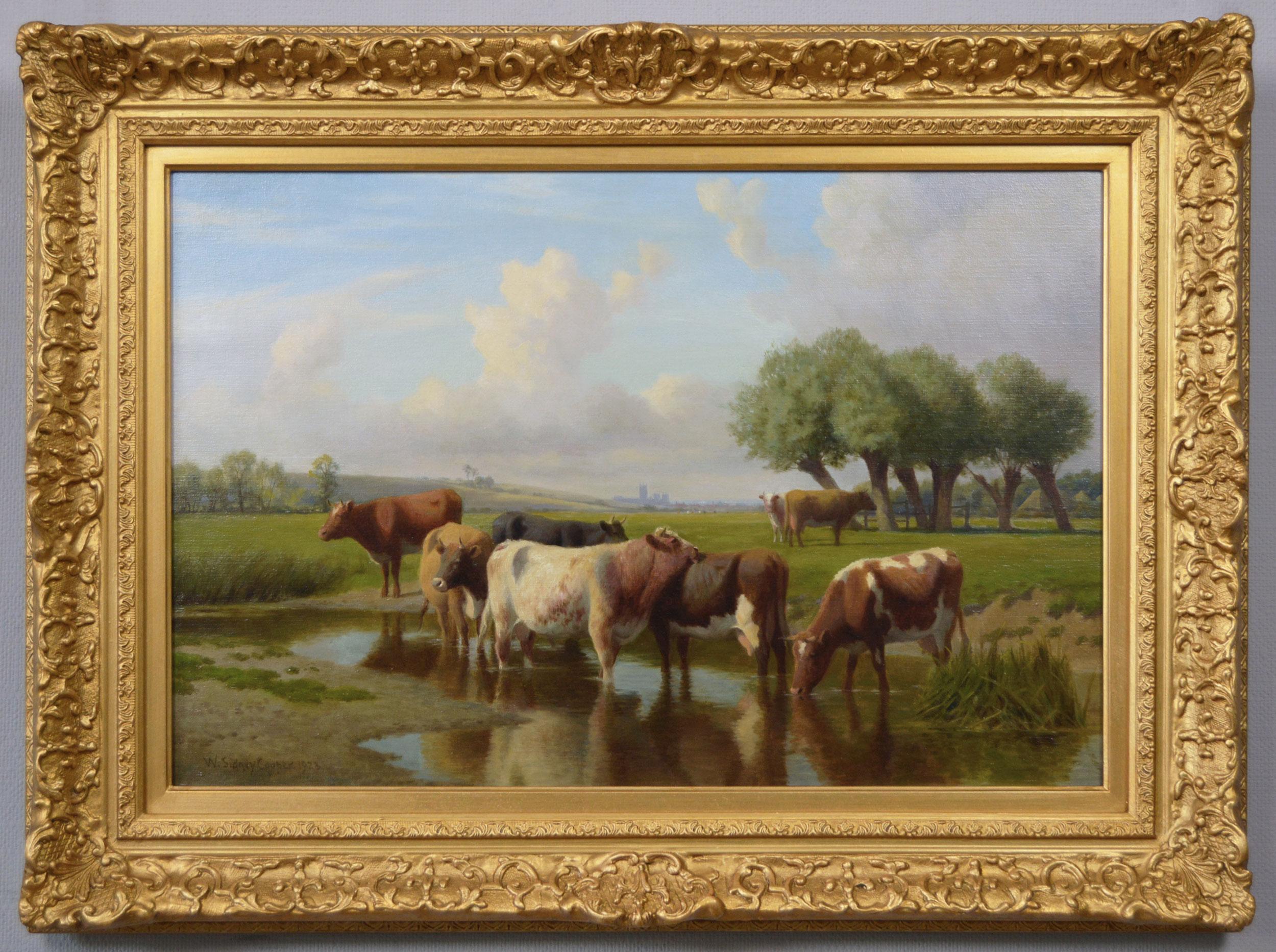Items Similar to 19th Century oil painting of a dray cart & shire horses in a brewery yard
Want more images or videos?
Request additional images or videos from the seller
1 of 15
William Henry Davis19th Century oil painting of a dray cart & shire horses in a brewery yard1839
1839
About the Item
William Henry Davis
British, (1783-1865)
The Brewery Yard
Oil on canvas, signed & dated 1839
Image size: 27 inches x 35 inches
Size including frame: 33.25 inches x 41.25 inches
This painting by William Henry Davis features draymen preparing a team of dray horses in the courtyard of a brewery. Dray horses or draught horses were a large breed of horses adapted for drawing heavy loads. During the 19th century, there were 3 main breeds used in Britain: Shire, Clydesdale and Suffolk Punch. The Shire horse and Suffolk Punch were the predominant breeds in Britain and were more commonly used for transporting beer barrels, especially in London. There would usually be a team of two or three horses pulling a dray with a ‘drayman’ to drive and a ‘trouncer’ to help load and unload the kegs. Polished horse brasses also became popular during this period and the Breweries would have the harnesses of their horses decorated with brass motifs. The dray horses became a symbol of prestige and were an impressive sight that helped promote the brewery in a highly competitive market. The motif of an anchor can clearly be seen on the horse brasses worn by the 3 dray horses. This undoubtedly refers to the Anchor Brewery based at Park Street, Southwark in London. The Anchor Brewery was established in 1616 by James Monger and at one time was the largest brewery in the world. From 1781 it was owned by Barclay Perkins & Co and merged with Courage Brewery in 1955. Brewing continued at the Anchor site until the early 1970’s.
William Henry Davis was born in Chelsea in 1783 to Richard and Sarah Davis (née Barrett). His father was huntsman to King George III and his brother Charles Davis became Huntsman for Queen Victoria. His older brother Richard Barrett Davis (1782-1854) was also an animal artist. Davis undoubtedly received an artistic education, most likely alongside his brother and is known to have travelled to Rome to study.
In 1803, at around the age of 20 he made his debut at the Royal Academy, continuing to exhibit there throughout his life. Although some of his early works included portraits and figures, he quickly focussed on painting sporting animals such as horses and greyhounds. He began exhibiting at the British Institute in 1817 and by 1818 had attracted the patronage of the Earl of Ilchester. As his reputation for painting portraits of horses and dogs grew he also began receiving commissions to paint cattle and sheep. From 1828, he exhibited at the Royal Society of British Artists. In 1837 he became Animal Painter to William IV and later Queen Victoria in 1839.
He lived for most of his life in Chelsea living at Church Lane but would travel around the country to work on commissions. As well as painting portraits of livestock for wealthy landowners, Davis was also commissioned by The Farmer magazine to produce a series of paintings which were reproduced as engravings.
He spent his final years living at 9 Upper Church Street, Chelsea. He died at his home on the 8 December, 1864 and was buried at Brompton Cemetery. Examples of his work are held by the Leicestershire Museum, Museum of Lincolnshire Life, National Army Museum, National Trust, Royal Agricultural University Collection and the Suffolk Punch Heavy Horse Museum. The National Trust Attingham Park holds a large collection of his portraits of prize winning cattle.
Presentation: The painting is housed in a new, English made gilt frame which is in excellent condition.
Condition: As with all of our original antique oil paintings, this work is offered in ready to hang gallery condition, having been professionally cleaned, restored and revarnished.
© Benton Fine Art
- Creator:William Henry Davis (1786 - 1865, English)
- Creation Year:1839
- Dimensions:Height: 33.25 in (84.46 cm)Width: 41.25 in (104.78 cm)Depth: 2.5 in (6.35 cm)
- Medium:
- Movement & Style:
- Period:
- Condition:
- Gallery Location:Nr Broadway, GB
- Reference Number:1stDibs: LU156212047932
About the Seller
4.9
Platinum Seller
These expertly vetted sellers are 1stDibs' most experienced sellers and are rated highest by our customers.
Established in 1972
1stDibs seller since 2015
273 sales on 1stDibs
Typical response time: <1 hour
Associations
The British Antique Dealers' AssociationLAPADA - The Association of Arts & Antiques DealersInternational Confederation of Art and Antique Dealers' Associations
- ShippingRetrieving quote...Ships From: Nr Broadway, United Kingdom
- Return PolicyA return for this item may be initiated within 3 days of delivery.
More From This SellerView All
- 19th Century landscape oil painting of sheep in a Sussex laneBy William Luker Sr.Located in Nr Broadway, WorcestershireWilliam Luker Snr British, (1828-1905) Sheep in a Sussex Lane with Pevensey Bay in the distance Oil on canvas, signed & dated 1875 Image size: 17.25 inches x 25.25 inches Size including frame: 23.25 inches x 31.25 inches A tranquil landscape scene of a shepherd and his flock resting in a lane near Pevensey Bay, Sussex by William Luker. The ruins of Pevensey Castle can be seen in the distance with the sea beyond. William Luker Snr was born in 1828 at Faringdon, Berkshire to William and Jane Luker (née Charlwood). His father was a plumber and glazier by trade and the family lived at London Street in Faringdon. Little is known about his early education and it is believed for the most part he was self -taught. However, given the quality of his work and the fact that his family were able to keep a servant, he may well have received some artistic tuition. By the early 1850’s, he had begun earning a living as an artist by advertising in local directories, earning commissions from local landowners. He made his debut at the Royal Society of British Artists in 1851 and was a prolific exhibitor there for over 40 years. He began exhibiting at the Royal Academy in 1852 and also exhibited at the British Institution. He married the artist Ada Augusta Margetts (1839-1930) on 27 October 1864. Their eldest son William Luker Jnr (1867-1951) also became a well-known artist. The couple soon moved to London where they lived at 22 Gloucester Terrace, Campden Hill from where they both exhibited. From 1867, they lived at 15 Sheffield Terrace in Kensington until 1874 when they moved for the final time to 22 Notting Hill Square, later renamed Campden Hill Square in 1893. He died at Campden Hill-square on 28 February, 1905. Luker specialised in landscapes featuring animals such as sheep and cattle, horses and deer. He travelled around visiting areas such as Sussex, Buckinghamshire, Kent, Wales and the Highlands. However, he also made trips to Egypt and Libya producing a series of Oriental scenes in the early 1860’s. His works show a great attention to detail and his use of a lighter palette gives his subjects a luminous quality that instantly attracts the viewer. Examples of his paintings are held by the Atkinson Art Gallery, National Library of Wales, Newstead Abbey...Category
19th Century Victorian Animal Paintings
MaterialsCanvas, Oil
- 19th Century Highland landscape oil painting of sheep near Loch AweLocated in Nr Broadway, WorcestershireWilliam Watson Jnr British, (1847-1921) On the Mountains, Loch Awe Oil on canvas, signed & dated 1892, further inscribed verso Image size: 12.5 inches x 18.5 inches Size including frame: 18.5 inches x 24.5 inches A wonderful painting of Highland sheep resting near Loch Awe by William Watson Jnr. Loch Awe is located in Argyll and Bute in the Scottish Highlands and this scene is taken from the mountain side overlooking the loch. William Watson was born in Islington in 1847, the son of the London miniature painter William John Watson (1810-1871) and his wife Caroline (née Butcher). His brothers Charles Watson (1837-1900) and Robert Watson (1855-1921) were also artists. His father seems to have travelled around and after spending time in Brighton, the family moved to Bransford Road in Worcester during the early part of the 1860’s. As well as being taught by his father, Watson received his early training in the studio of Sir Francis Grant PRA (1803-1878). He later became a pupil of Sir Edwin Henry Landseer RA (1802-1873) and Rosa Bonheur (1822–1899). Both Landseer and Bonheur had a great influence on his work and he began specialising in scenes of cattle and sheep. By 1866 he had become a full time artist and began exhibiting at the Royal Society of British Artists. Perhaps to take advantage of the inspiring scenery, Watson moved to Birkenhead, Cheshire where in 1871 he met and married Eleanor Davies who was from Caernarvonshire. Four of their children Sidney Watson (1881-1931), Caroline Ellen...Category
19th Century Victorian Animal Paintings
MaterialsCanvas, Oil
- 19th Century landscape oil painting of cattle near Canterbury CathedralBy William Sidney CooperLocated in Nr Broadway, WorcestershireWilliam Sidney Cooper British, (1854-1927) Cattle Watering near Canterbury Cathedral Oil on canvas, signed & dated 1923 Image size: 15.5 inches x ...Category
Early 20th Century Victorian Animal Paintings
MaterialsCanvas, Oil
- 19th Century landscape oil painting of the river Lledr near Bettws-y-coedBy Henry H. ParkerLocated in Nr Broadway, WorcestershireHenry H Parker British, (1858-1930) The River Lledr, Bettws-y-coed Oil on canvas, signed, further signed & inscribed verso Image size: 19.5 inches x 29.5 inc...Category
19th Century Victorian Landscape Paintings
MaterialsCanvas, Oil
- 19th Century landscape oil painting of sheep near a five bar gateBy Charles Jones (b.1836)Located in Nr Broadway, WorcestershireCharles Jones British, (1836-1892) Sheep by a Five Bar Gate Oil on panel, signed with monogram & dated (18)90, further inscribed verso Image size: 11.5 inches x 19 inches Size includ...Category
19th Century Victorian Animal Paintings
MaterialsCanvas, Oil
- 19th Century Scottish landscape oil painting of Highland sheep at Glen CoeBy William WatsonLocated in Nr Broadway, WorcestershireWilliam Watson Jnr British, (1847-1921) Morning, Head of Glen Coe Oil on canvas, signed & dated 1897, further inscribed verso Image size: 12.5 inches x 18.5 inches Size including frame: 19.75 inches x 25.75 inches A superb Scottish landscape painting of Highland Sheep at the head of Glen Coe by William Watson. The sheep and their lambs are depicted grazing in the morning light with the dramatic mountains beyond. Glen Coe is a valley located in the Highlands to the North of the county of Argyll and close to the province of Lochaber. The area, which became infamous for the Massacre of Glencoe is one of Scotland’s most scenic Highland glens. William Watson was born in Islington in 1847, the son of the London miniature painter William John Watson (1810-1871) and his wife Caroline (née Butcher). His brothers Charles Watson (1837-1900) and Robert Watson (1855-1921) were also artists. His father seems to have travelled around and after spending time in Brighton, the family moved to Bransford Road in Worcester during the early part of the 1860’s. As well as being taught by his father, Watson received his early training in the studio of Sir Francis Grant PRA (1803-1878). He later became a pupil of Sir Edwin Henry Landseer RA (1802-1873) and Rosa Bonheur (1822–1899). Both Landseer and Bonheur had a great influence on his work and he began specialising in scenes of cattle and sheep. By 1866 he had become a full time artist and began exhibiting at the Royal Society of British Artists. Perhaps to take advantage of the inspiring scenery, Watson moved to Birkenhead, Cheshire where in 1871 he met and married Eleanor Davies who was from Caernarvonshire. Four of their children Sidney Watson (1881-1931), Caroline Ellen Watson (1871-1947), William Robert Charles Watson (1873-1928) and Walter James Watson...Category
19th Century Victorian Animal Paintings
MaterialsCanvas, Oil
You May Also Like
- 19th century Scottish Highland lock landscape with Highland Cattle drinkingLocated in Woodbury, CTLate 19th century Scottish Highland Lock landscape, with Cattle watering E.Mulready was almost certainly a pseudo name for William Langley a well known English painter of landscapes...Category
1890s Victorian Landscape Paintings
MaterialsOil, Canvas
- 19th century Scottish Highland lock landscape with Highland Cattle drinkingLocated in Woodbury, CTLate 19th century Scottish Highland Lock landscape, with Cattle watering E.Mulready was almost certainly a pseudo name for William Langley a well known English painter of landscapes...Category
1890s Victorian Landscape Paintings
MaterialsOil, Canvas
- "A River Landscape with Wild Horses", Victorian original, oil on canvasBy John Frederick Herring JrLocated in Nutfield, SurreyThis is an original unique oil painting by the artist. Born into an artistic family in Doncaster, England during 1820. Best known for his equine art, of the same character as those of the elder Herring, including "The Home Farm," "The Homestead," "The Farm-Yard," etc.John F. Herring, Jr. was born in Doncaster, South Yorkshire c.1820, to the well-known 19th-century artist John Frederick Herring, Sr. (1795-1865), who at the time, was considered one of England's great Sporting and Equestrian artists, patronized by the English aristocracy. The father's mastery of the brush, and popularity with the nobility, served his son, Herring, Jr., well. Early on, John, Jr. was exposed to fine painting and wealthy patrons. Recent reference books state that Herring, Sr.'s first child was named "John Frederick Herring, Jr." and was born on June 21, 1815. John Herring, Jr. developed a love for painting, a passion also shared by his brothers Charles and Benjamin. Three of the four brothers became artists, painting in the same style as their father, often collaborating on a single painting. In the years after 1836, Herring, Sr., feeling threatened by the teenage John Herring, Jr.'s ability and growing popularity, began incorporating the tag "SR" at the end of his signature. John Herring, Jr. continued painting in the tradition of his father, the sporting and animal pictures...Category
19th Century Victorian Landscape Paintings
MaterialsCanvas, Oil
- English 19th century forest landscape with horses in the New Forest Hampshire UKBy William BradleyLocated in Woodbury, CTEnglish landscape painter from the 1870's who exhibited at the Royal Academy and the British Institute in London. He mostly painted in watercolors and this example would have been p...Category
1860s Victorian Landscape Paintings
MaterialsOil, Canvas
- 19th century English fox hunter on his horse oil in a landscapeBy William Joseph ShayerLocated in Woodbury, CTWilliam Joseph Shayer English sporting painter from the 19th century. He painted mostly on a small scale with great detail and quality. The son of William Shayer senior he must ha...Category
1870s Victorian Animal Paintings
MaterialsCanvas, Oil
- 19th century English Harvest landscape with horses, farmers, children, familyLocated in Woodbury, CTHenry Brittian Willis English plough team at rest during harvest Summertime. A painting by Henry Brittiam Willis capturing a 19th-century English plough team, complete with horses,...Category
1850s Victorian Landscape Paintings
MaterialsCanvas, Oil
Recently Viewed
View AllMore Ways To Browse
Study Of A Horse
Horse Painting In Frame
Artist Davis
Oil Painting Of A King
Polish 19th Century Art
Painting Of London 1970s
Two Horse Paintings
Large Oil Of Animals
Oil Painting From Early 20 Century
Brown Oil Painting Horse
19th Century Oil Paintings Of Animals
Horse Painting Old
19th Horse Painting
Antique Oil Painting Horse Paintings
Antique Oil Painting Horse
Horse Oil Paintings Antique
19th Century Painting Horse
Paintings By William Henry

